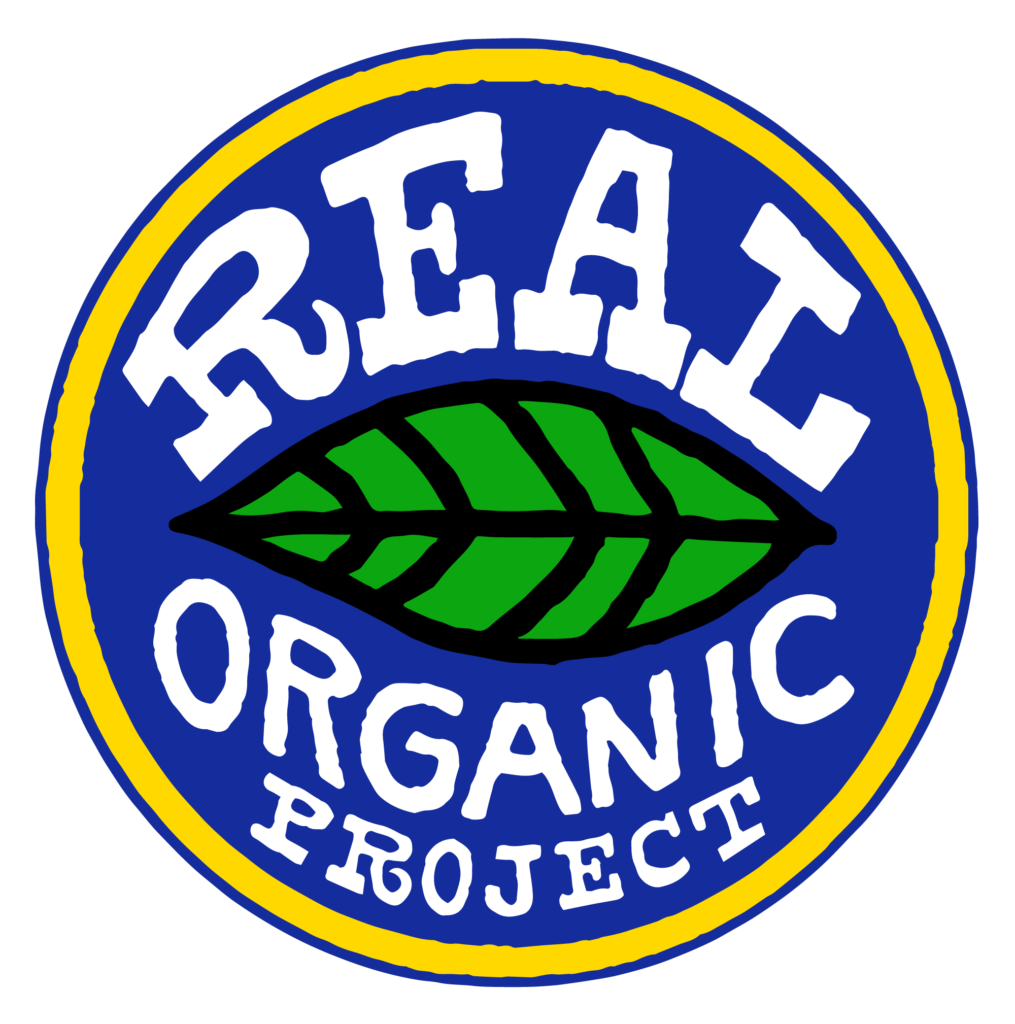A sample text widget
Etiam pulvinar consectetur dolor sed malesuada. Ut convallis
euismod dolor nec pretium. Nunc ut tristique massa.
Nam sodales mi vitae dolor ullamcorper et vulputate enim accumsan.
Morbi orci magna, tincidunt vitae molestie nec, molestie at mi. Nulla nulla lorem,
suscipit in posuere in, interdum non magna.
|
August 12th, 2013 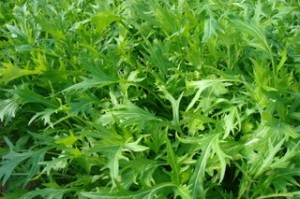 This week’s harvest: zucchini, lettuce, cilantro, tomatoes, cucumber, dill, sweet red and white onions, kale, chard, eggplant (group A), strawberries (group B) This week’s harvest: zucchini, lettuce, cilantro, tomatoes, cucumber, dill, sweet red and white onions, kale, chard, eggplant (group A), strawberries (group B)
“You are what you eat”, we’ve heard it from day one. As farmers, we are often asked about our diet. We have the opportunity to witness the differences between growing vegetables in poor vs. nutritious soil and there is overwhelming evidence that nutrition affects our health as well. Though the science of nutrition is in its infancy, we are bombarded with information about what we should and shouldn’t be eating and it can be difficult to know what to listen to. Some diets recommend veganism, others promote eating grass fed meat and dairy. But, what we all seem to agree on is this: eat your vegetables and eat lots of them. In the history of diets, I can’t think of one that cuts out vegetables.
Some of the healthiest plants for us are brassicas. Brassicas include kale, cabbage, cauliflower, broccoli, kohlrabi, turnips, brussel sprouts, and mustard greens (like arugula, mizuna, tat soi). You may have noticed how spicy our arugula is in mid-summer (it will sweeten again as temperatures cool), but it is the spice in them that makes them so good for you. Brassicas are rich in sulfur containing antioxidants, vitamin C, carotenoids, and immune-boosting properties (antiviral, antibacterial, and anticancer activity). And, like onions and garlic, research shows that lightly cooking the brassicas maximizes the availability of the sulfur compounds. Lightly stir-frying or steaming vegetables and adding a few herbs and seasonings is the go-to meal in our house. Tonight, I dipped 12 giant kale bundles into steaming water, chopped them up, and fit them all into 2 ziplock freezer bags!
We’ve learned a few things about how to grow brassicas this year (brassicas are particularly prone to problems, perhaps because insects find them so nutritious)!
First, in June and July, it is absolutely essential to cover brassicas with remay to protect them from flea beetles. Fortunately flea beetles in Durango only have one life cycle per year so we can uncover the brassicas by August.
Second, aphids and sulfur butterfly caterpillars love brassicas. Attracting beneficials to the garden to eat these larval pests is crucial!
Finally, healthy plants do not get sick. Maintaining proper soil moisture and fertility is crucial to keeping the bugs at bay. Proper plant spacing to encourage air circulation and access to nutrients is just as important. Older plants are more susceptible to aphids than younger ones and replacing them with successive sowings is necessary later in the season.
Though they may not be the easiest to grow, brassicas pack in the nutrition and we think they are worth the trouble. We are particularly fond of mizuna. It is milder than arugula has and more tender than kale. Nothing matches its versatility; you can eat it fresh, bake or stir-fry it. Plus, it grows year-round in extreme heat and cold so for that reason alone, you are supporting local farmers by eating it.
So before you decide “what’s for dinner”, ask yourself, “Have you had your serving of brassicas today?”
Use up your zucchinis and moisten your corn bread with this seasonal recipe for zucchini corn bread: http://www.epicurious.com/recipes/food/views/Zucchini-Cornbread-366395
August 5th, 2013  This Week’s Harvest: basil, cilantro, dill, tomatoes, sweet white onions, kale, chard, lettuce, arugula, zucchini, elephant garlic, strawberries (Group A) This Week’s Harvest: basil, cilantro, dill, tomatoes, sweet white onions, kale, chard, lettuce, arugula, zucchini, elephant garlic, strawberries (Group A)
Happy Harvest Day!
We’ve decided to give you a little extra basil this week to make pesto. It’s the perfect time because the stems have not become fibrous, and the plants are still producing a lot of tender leaves. Traditionally, basil is made with pine nuts, but a cheaper alternative is to use walnuts instead. We make pesto every week after farmers market with the basil that doesn’t sell. We store it in ziplock bags in the freezer so that we can use smaller portions at a time. This gives us a year-round supply and brings back the taste of summer throughout winter.
One of the best parts of the season has been working with the many volunteers. One in particular comes almost daily to weed, help harvest for CSA and help us run the farmers market stand. Fran has also taken it upon herself to keep the strawberry patch weed free, she’s invested so much time in the patch that we’ve taken to calling it Fran’s Patch (we’re working on a sign). 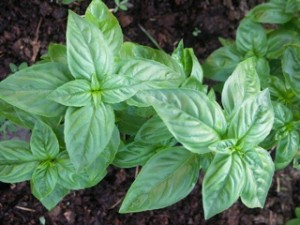 It’s a job that we always put on the back burner since we’re still trying to figure out how to grow them here. Last year we lost our entire planting to a late frost just after we got them in the ground. This year, we were cautious and planted fewer, and were fortunate all survived. Their production should peak in August, but due to the smaller quantities we will need to take turns giving them out. While it’s a struggle, we grow them because they just make life better. To Fran, the flavor of the berries makes her day and getting to nibble on a few as she weeds is worth the labor. In the end we all benefit from her hard work. It’s a job that we always put on the back burner since we’re still trying to figure out how to grow them here. Last year we lost our entire planting to a late frost just after we got them in the ground. This year, we were cautious and planted fewer, and were fortunate all survived. Their production should peak in August, but due to the smaller quantities we will need to take turns giving them out. While it’s a struggle, we grow them because they just make life better. To Fran, the flavor of the berries makes her day and getting to nibble on a few as she weeds is worth the labor. In the end we all benefit from her hard work.
Watermelon Salad
- Chop watermelon & cantaloupe/ honeydew melon.
- Stack 3-5 basil, roll like a cigar and cut into strips. Toss with melon.
- Dressing: 2 tbsp virgin olive oil, 1/4 cup honey, 1/4 cup lime juice, salt to taste.
Walnut Basil Pesto
- 2 cups packed Basil
- 1/3 cup extra virgin olive oil
- 1/2 cup walnut pieces
- 2 cloves garlic
- 1/2 cup grated Parmesan cheese
Process until smooth texture in food processor. Add 2 tbsps pasta cooking water before adding to pasta. Or, freeze in ziplock bag for future use.
August 5th, 2013 Peach and Tomato Gazpacho
- 1 1/2 lb tomatoes, chopped (4 cups)
- 1 lb peaches, pitted and chopped (2 cups)
- 1/4 cup crushed ice
- 2 tablespoons chopped shallot (1 medium)
- 2 tablespoons olive oil
- 1 1/2 tablespoons white-wine vinegar
- 1 tablespoon chopped fresh tarragon
- 1 teaspoon salt
- 1/2 teaspoon black pepper
- 1/4 to 1/2 cup water
Purée two thirds of tomatoes and half of peaches with ice, shallot, 1 tablespoon oil, 1 tablespoon vinegar, 2 teaspoons tarragon, 3/4 teaspoon salt, and 1/4 teaspoon pepper in a blender until very smooth, about 1 minute. Force through a medium-mesh sieve into a large glass measure, discarding solids. Stir in water to desired consistency. Toss together remaining tomatoes and peaches with remaining tablespoon oil, remaining 1/2 tablespoon vinegar, remaining teaspoon tarragon, and remaining 1/4 teaspoon each of salt and pepper in a bowl. Serve soup in bowls topped with tomato peach salsa.
July 29th, 2013 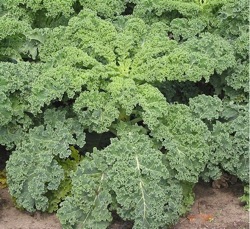 This week’s harvest: Spinach, Lettuce, Arugula, Kale, Chard, Zucchini, Tomatoes, Basil, Cilantro, Dill, Onion, Garlic, Eggplant (group A) This week’s harvest: Spinach, Lettuce, Arugula, Kale, Chard, Zucchini, Tomatoes, Basil, Cilantro, Dill, Onion, Garlic, Eggplant (group A)
It’s amazing how short, but incredibly productive our season is. It must be the high altitude sun! The majority of our harvest is still ahead of us even as we head into August. The warm season crops start producing slowly but before you know it, there’s too much! That is the case for zucchini already and it is soon to be the case for tomatoes and cucumbers.
You’ll be getting eggplant every other week until frost (we’ll divide the CSA into 2 groups and alternate which group gets eggplant each week). We’re in a time of too much kale and lettuce on the farm. So, if you would like more than what you receive in your CSA, come and get it! The farm is open to you to come pick as much kale and lettuce as you can eat! Just give Linley a call beforehand so we can show you where to go (970-317-0309).
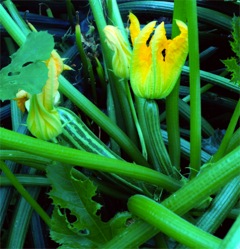 Amazingly, the biggest complaint about most CSA’s are that people receive more produce than they can use and they feel wasteful. Don’t let that happen to you! Look online for quick, easy ways to use your produce (juicing is very popular now) and be sure to freeze what you can’t eat each week (if you have time, blanching for 1 minute in boiling water reduces the space it takes up in the freezer). Below are a few good recipes that we make routinely. Amazingly, the biggest complaint about most CSA’s are that people receive more produce than they can use and they feel wasteful. Don’t let that happen to you! Look online for quick, easy ways to use your produce (juicing is very popular now) and be sure to freeze what you can’t eat each week (if you have time, blanching for 1 minute in boiling water reduces the space it takes up in the freezer). Below are a few good recipes that we make routinely.
Kale Chips
- 1 Bundle Kale – remove ribs and chop or rip coarsely (about 1-2 inch pieces)
- 2 Tablespoons Olive Oil (the kale won’t crispen if you use too much)
- Sprinkle with sea salt (you can add cumin, red pepper or any favorite spice)
- Bake 300, 20 minutes stirring half way through.
Veggie Frittata
- 1 Tablespoon olive oil
- 1 sweet white onion
- 1 cup chopped kale
- ¼ cup zucchini
- salt and pepper
- 2 eggs, whisked with 2 Tablespoons milk
- Garnish with fresh herbs – cilantro, basil or dill
In a large skillet, add oil, onion, kale and zucchini. Stir-fry for 3-5 minutes. Turn heat to low and pour eggs over vegetables, and cover until cooked through (about 5 minutes.
July 22nd, 2013 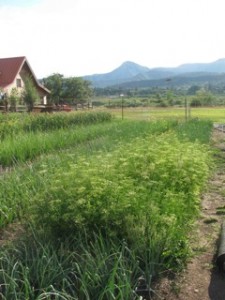 This week’s harvest: lettuce, zucchini, chard, kale, radishes, tomatoes, onions, , basil, cilantro, garlic (in case you don’t want to break into your braid). This week’s harvest: lettuce, zucchini, chard, kale, radishes, tomatoes, onions, , basil, cilantro, garlic (in case you don’t want to break into your braid).
Wow, the farm is growing fast these days. It seems we notice the plants getting bigger every night! We had no idea that the zucchinis would already be producing since it seems like yesterday we were wondering when they would start growing. But sure enough many escaped our attention and we found oversized zucchinis this Monday! Not to worry, though, we had one tonight for dinner and it was juicy and tender as ever. We’ll have to keep a daily watch on these guys from now until frost to make sure we harvest before they get too big. It seems that no matter how closely we look, inevitably a few always escape our harvest knife and turn into baseball bats overnight. We like to take the large ones, slice them thickly and throw them on the grill with olive oil, salt, and pepper. Or, chocolate zucchini cake (see below) if you have the time.
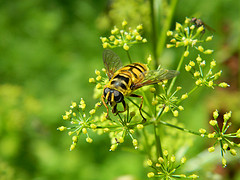 One success this year has been the balance between good bugs and bad bugs. We have the parsley flowers to thank for much of this success. The parsley was planted and harvested last fall,but it overwintered magnificently and we left it to flower. The nectar has been attracting parasitic wasps, lady bugs, bees, hoverflies, and lacewings. The hoverflies (pictured above) seem to be the most abundant and if you stand close you can hear them buzzing by the hundreds! Hoverfly larvae eat aphids (the most common pest of kale and many other farm crops) so they are a welcome site. One success this year has been the balance between good bugs and bad bugs. We have the parsley flowers to thank for much of this success. The parsley was planted and harvested last fall,but it overwintered magnificently and we left it to flower. The nectar has been attracting parasitic wasps, lady bugs, bees, hoverflies, and lacewings. The hoverflies (pictured above) seem to be the most abundant and if you stand close you can hear them buzzing by the hundreds! Hoverfly larvae eat aphids (the most common pest of kale and many other farm crops) so they are a welcome site.
If you’re having trouble finishing your veggies, be sure to freeze them for winter. If you chop them up, you can pack much more into ziplock bags or reusable containers. I’ve never had the patience to blanch the veggies first, but Werner dips entire kale leaves for a few seconds into boiling water and then puts them into ice cold water before freezing. Blanching is supposed to preserve color, flavor and nutrition before freezing. If you’re in a rush, however, I’ve always found the chop and freeze method to work. You’ll be happy that you took the time when you can add them to your mid-winter soups.
As always, thanks for your support and we’ll see you Tuesday!
Linley, Peter, Werner
Chocolate Zucchini Cake
- 2 cups all-purpose flour (mixing 1 cup white with 1 cup wheat works well too)
- 1 3/4 cups white sugar *
- 3/4 cup unsweetened cocoa powder
- 2 teaspoons baking soda
- 1 teaspoon baking powder
- 1/2 teaspoon salt
- 1 teaspoon ground cinnamon
- 4 eggs
- 1 cups vegetable oil *
- 1/2 cup applesauce *
- 3 cups grated zucchini
- 3/4 cup full-size chocolate chips (miniatures are too small)
* (If applesauce isn’t available, increase sugar to 2C and vegetable oil to 1 1/2C).
- Preheat oven to 350 degrees F (175 degrees C). Grease and flour a 9×13 inch baking pan.
- In a medium bowl, stir together the flour, sugar, cocoa, baking soda, baking powder, salt and cinnamon.
- Add the eggs and oil, mix well.
- Fold in the nuts and zucchini until they are evenly distributed. Pour into the prepared pan.
- Bake for 50 to 60 minutes in the preheated oven, until a knife inserted into the center comes out clean. Cool cake completely before frosting with your favorite frosting (if desired).
July 15th, 2013 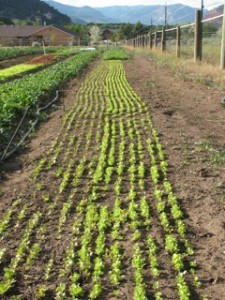 This Week’s Harvest: Garlic Braids, Tomatoes!, Salad Greens (1 pound), Spinach, Mini White Sweet Onions, Chard, Kale, Dill ($46 farmers market value!!) This Week’s Harvest: Garlic Braids, Tomatoes!, Salad Greens (1 pound), Spinach, Mini White Sweet Onions, Chard, Kale, Dill ($46 farmers market value!!)
Thanks to Werner, Peter, and our work/share volunteers, I had a lovely time with my family in Salt Lake last week and the produce still made its way to you. The farm grew so much in just the 5 days that I was gone and I was so emotional when I saw it again upon my return. It truly is a dream come true to have this much space to farm and to watch it become so productive. Thank you Janet and Peter for the use of your land!
Last year’s slogan was “plant in June, weed in July and harvest in August and September”. But, harvesting has become a full time job earlier this year and I’m happy to say that we have a few new veggies ready this week, especially the tomatoes. We started these early tomatoes in our south-facing windows in February, transplanted them into bigger pots in March and then into the high hoops May 1. Rather than heating the tunnels with large propane heaters, we covered the plants with heavy frost blankets low to the ground and used a kerosene heater on nights below 25 degrees, significantly reducing our carbon footprint for an early tomato. Every morning beginning in May we have peeled away the frost blanket and every evening we have tucked them back to bed. Removing the blanket allows the sun to warm the soil and replacing it at night traps in the heat gathered from the day. The big debate among farmers is how thick the frost blankets should be. Thinner frost blankets allow more light to come in through in the day, and therefore they don’t need to be removed. But to maximize solar warmth and trap in this heat at night, we go to the extra effort to pull the blanket on and off. Interestingly, we’ve found that there is no air temperature difference between outside and inside the outer plastic layer, but the combination of the plastic and the frost blanket low to the ground adds up to 20 degrees under the blanket! (The plastic layer does provide wind protection even though it doesn’t help keep the plants warm at night). We are very proud of how early these tomatoes are with very minimal heating. Each year, we have been able to provide veggies earlier and I plan to continue that trend. Next year, I’m planning for an April 1 tomato planting and more veggies under tunnels and frost blankets.
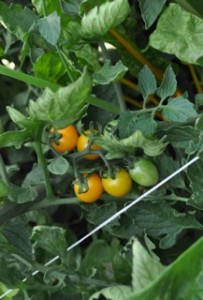
Dill is new this week too. Normally we like to provide it with cucumbers, but it’s also good with potatoes, fish, and any summer salad. A little goes a long way! We have a large lettuce harvest this week and for several weeks to come so email us your favorite homemade dressing so we can share it with you next week. Ours is a mix of olive oil, mustard, balsamic vinegar (thick and aged), salt and pepper. You can add a little honey if you like it sweeter. We also love Annie’s Shitake Mushroom.
The third new item is garlic. We’ve harvested our soft neck garlic, Inchelium Red. This variety was discovered on the Colville Indian Reservation in Northern Washington and has a warm “tingly” taste (according to Big John, our source for Organic seed). It will store for 9 months on your wall in the braids, just break the bulbs off when you’re ready to use them. We’ll have more garlic to come (our hardneck and elephant ear garlic). We give you the softneck garlic first because it can cure on your wall rather than in our barn. Curing takes just a week in this dry climate. You can eat the garlic before it is cured – it’s just harder to peel (and to break off the braid).
See you Tuesday at Linda’s from 3-6. Because of the thunder storms we’ve been setting up inside!
Linley, Peter, and Werner
July 8th, 2013 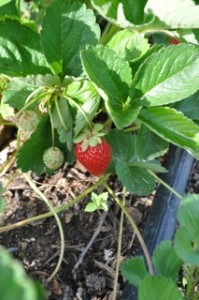 CSA Share Week 3: Chard, Kale, Spinach, Green Onions, Turnips, Basil, Mint CSA Share Week 3: Chard, Kale, Spinach, Green Onions, Turnips, Basil, Mint
We hope you had a wonderful 4th of July weekend. We watched the fireworks on a ledge by the college with a view up the valley, the Animas winding through town, and the sun setting over the La Platas. Wow, we are so privileged to farm in a town with a view like that! With June and the month of planting behind us, we move into July: the month of weeding! Since it’s the first year of production in much of our growing space, the weeds are particularly dense. In many of the seed beds we couldn’t see the crop that was planted and have painstakingly weeded around every little seedling!
Thank you so much for your responses to our question about what a CSA means to you. We were comforted to learn that everyone we heard from believed that we are in this together, whether feast or famine. Due to the hail last week, we harvested ripped greens and removed pelted green tomatoes, but our damage was minimal. If you went to Farmers’ Market last weekend you may have noticed Chimney Rock’s stand was devoid of veggies. They were hit hard by golf ball sized hail ripping through their greens, denting their fruit, and completely wiping out their tomatoes. 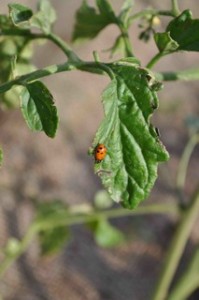 The farmers were depressed and they told us they would give their CSA what they could and start over. It’s not too late to sow again successive crops like greens, carrots, beets, radishes, beans, and peas. It’s hard to imagine a season where our CSA couldn’t at least provide these short-season veggies throughout the season. And some of our plants come from tunnels and the greenhouse that would not be affected by hail. Our CSA truly allows us to keep farming in this region year after year and we thank you immensely. Our growing partner, Werner has written a letter below in support of the CSA concept as well. The farmers were depressed and they told us they would give their CSA what they could and start over. It’s not too late to sow again successive crops like greens, carrots, beets, radishes, beans, and peas. It’s hard to imagine a season where our CSA couldn’t at least provide these short-season veggies throughout the season. And some of our plants come from tunnels and the greenhouse that would not be affected by hail. Our CSA truly allows us to keep farming in this region year after year and we thank you immensely. Our growing partner, Werner has written a letter below in support of the CSA concept as well.
If you’re having trouble coming up with ways to use the turnips stir-fry greens, a farm volunteer recommended frying turnip and beet greens with bacon and adding the turnips to cornmeal dumplings. The recipe is below.
This is Werner, partner of Linley and Peter, writing this newsletter. Up to now, Linley has been writing your letters exclusively, because she is the only one who still finds the energy after a busy week at the farm to sit down at night and write. Yet, after last week’s letter when Linley talked about hail and the CSA concepts, I decided to express my personal feelings.
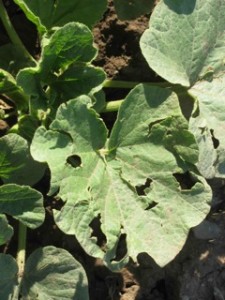 This is now my third year working with Linley. Having gardened and worked on farms for many years, I decided last year to join Linley. She is knowledgeable, creative and amazingly hard working. Making a living farming takes all three and even then it’s a challenge. She has stated to me many times that her main commitment is to the CSA, with the Farmers Market and restaurants coming second. Should we ever be short of vegetables, which has not happened yet, we favor our CSA members. Last year our members, when averaged over a season, received about twice the value in produce when compared to purchasing at the Farmers Market, a record we intend to maintain. Yet, as any farmer knows, like last week’s hail we cannot control natural events (Ps: When looking more carefully the next morning we noticed more damage than we expected like shredded leaves and bruised tomatoes). Yet, be assured, should we have hail or other natural events that could damage our crops, we will do what it takes to keep on going, like seeding fast growing crops. This is now my third year working with Linley. Having gardened and worked on farms for many years, I decided last year to join Linley. She is knowledgeable, creative and amazingly hard working. Making a living farming takes all three and even then it’s a challenge. She has stated to me many times that her main commitment is to the CSA, with the Farmers Market and restaurants coming second. Should we ever be short of vegetables, which has not happened yet, we favor our CSA members. Last year our members, when averaged over a season, received about twice the value in produce when compared to purchasing at the Farmers Market, a record we intend to maintain. Yet, as any farmer knows, like last week’s hail we cannot control natural events (Ps: When looking more carefully the next morning we noticed more damage than we expected like shredded leaves and bruised tomatoes). Yet, be assured, should we have hail or other natural events that could damage our crops, we will do what it takes to keep on going, like seeding fast growing crops.
Personally, I like the CSA concept for the following reasons:
- The food is produced locally, instead of shipped hundreds or often thousands of miles. This means that vegetables are picked when ready to be eaten, instead of picked ahead of time and varieties are chosen for taste rather than shelf life.
- The consumer gets to know the farmer. He/she can visit him and even work on the farm, which is one reason we have work shares. This creates a trust based relationship. Farmers, like gardeners, love what they do and rarely do it only for the money. Making soil productive and feeding people is an essential need that must be in the genetic make-up of those who like to build soil and dig in it.
- Consumers are supporting local farmers keeping money in the local economy. This is measured by using the multiplier effect. Local farms and ranching operations have the highest multiplier of any major economic segment, because the dollar turns over several times in the local economy.
- Consumers are providing farmers with income early in the season when farmers are spending to get the farm started, while sharing in the risks and benefits.
Please share your opinion with us by email, on Tuesday at the stand or visit us at the farm.
-Werner
Turnip Dumplings (served with bacon turnip greens)
- ½ cup yellow cornmeal
- ½ cup flour
- ½ teaspoon garlic salt
- 1/8 teaspoon pepper
- 1 egg
- ¼ cup milk
- 1 Tablespoon butter
- ¼ cup finely chopped turnips
Sift dry ingredients in bowl. Stir in egg, milk, turnips, and butter. Drop batter by teaspoonful into simmering broth. Cover tightly and simmer for 15 minutes. Salt and pepper to taste. Stir-fry turnip greens and a few slices of bacon and serve with dumplings.
June 30th, 2013 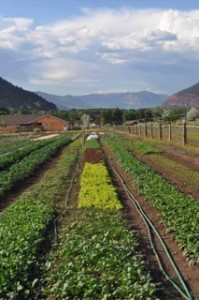 This Week’s Harvest: Spinach, Kale, Chard, Basil, Mini Sweet Red and White Onions, Turnips, Mixed Salad Greens This Week’s Harvest: Spinach, Kale, Chard, Basil, Mini Sweet Red and White Onions, Turnips, Mixed Salad Greens
With just 2 seasons behind us, there’s so much we’re still learning about farming in this area. Especially balancing the need to support a family on the land, but also responsibly taking care of the land we cultivate. Last week, we began to feel better about our irrigation and finished planting the farm. “The only thing that can ruin us now is hail,” we said. Sure enough, last Saturday it hailed marble-sized pellets for 15 minutes as we held our breath. Fortunately the hail hit the ground softly and we ended up thankful for the moisture.
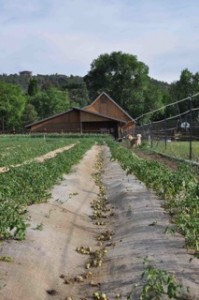 This brings up an interesting aspect of what a CSA has traditionally meant: shared risk between the community and the farmer. CSA’s have been canceled by many things including hail, frost, drought, insects, disease, pollination, fire, and herbicide drift from neighbors that spray on windy days. Seasons can also be exceptionally productive and the CSA has traditionally meant that we feast or famine together. The “famine together” concept is one that we, your farmers, have trouble accepting, since we feel the need every week to supply you with as many vegetables as we can to thank you for your support early in the season. Hopefully “famine together” is a bridge we will never have to cross. As CSA members, what are your thoughts on the matter? If we had said that there was a “no refund policy” despite any unforeseen disasters that strike the farm, would it have prevented you from signing up? The more likely scenario: feast! This brings up an interesting aspect of what a CSA has traditionally meant: shared risk between the community and the farmer. CSA’s have been canceled by many things including hail, frost, drought, insects, disease, pollination, fire, and herbicide drift from neighbors that spray on windy days. Seasons can also be exceptionally productive and the CSA has traditionally meant that we feast or famine together. The “famine together” concept is one that we, your farmers, have trouble accepting, since we feel the need every week to supply you with as many vegetables as we can to thank you for your support early in the season. Hopefully “famine together” is a bridge we will never have to cross. As CSA members, what are your thoughts on the matter? If we had said that there was a “no refund policy” despite any unforeseen disasters that strike the farm, would it have prevented you from signing up? The more likely scenario: feast!
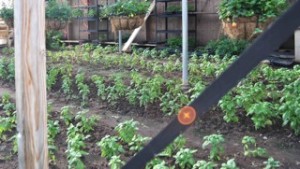 With over 3,000 tomato plants in the ground, start making room in your pantry and freezer for sauce! Prunning our first tomatoes has allowed the plants to invest in more leaf production which will result in higher yields. Also, a reminder that pickup is at Linda’s Local Food Cafe Tuesdays from 3pm-6pm. We look forward to seeing you! With over 3,000 tomato plants in the ground, start making room in your pantry and freezer for sauce! Prunning our first tomatoes has allowed the plants to invest in more leaf production which will result in higher yields. Also, a reminder that pickup is at Linda’s Local Food Cafe Tuesdays from 3pm-6pm. We look forward to seeing you!
Chickpea, Turnip, and Corn Curry
- 2 Tablespoons olive oil
- 1/2 onion, diced
- 2 cloves garlic, minced
- 1 Tablespoon ground cumin
- 2 Tablespoons curry powder
- 1 (15 ounce) can garbanzo beans
- (chickpeas), undrained
- 1/2 red bell pepper, diced
- 1/2 turnip, peeled and diced
- 1 cup corn kernels
- 1/2 (15 ounce) can tomato sauce
- 1 pinch crushed red pepper flakes
- (optional)
- 1 pinch salt
- 1 pinch cracked black pepper
Heat the olive oil in a large saucepan over medium heat. Stir in the onion, garlic, cumin, and curry powder; cook and stir until the onion has softened and turned translucent, about 5 minutes. Add the garbanzo beans, red bell pepper, turnip, corn, and tomato sauce. Season with red pepper flakes, salt, and black pepper. Bring to a simmer over medium-high heat, then reduce heat to medium-low, cover, and simmer until the vegetables are tender and the curry has thickened, 1 1/2 to 2 hours.
June 23rd, 2013 Dear Adobe House Farm CSA Members,
This Tuesday is our first CSA pick-up at Linda’s Local Food Cafe from 3-6 (unless you’ve arranged for delivery).
Your share will include: spinach, kale, chard, garlic scapes, basil, cilantro, turnips, mini sweet red and white onions
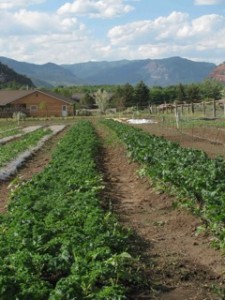 Spring on the farm has been full of challenges in the process of opening an acre of new growing space. For the first time, we’re irrigating from a pond that is fed from the Reid Ditch, although our greens, greenhouse, tunnels, strawberries, garlic and onions are remain on city water. Unlike some of our farming friends this season, we will likely have irrigation water all summer since our water source comes from the Animas River. So far, at least 3 of the farms at farmers market will be cut off from their irrigation water in the next few weeks! Werner Heiber has been the master mind behind our irrigation system this year. Having tried to make use of the existing sprinkler heads, we soon realized we needed to access the main irrigation lines in order to have a consistent water supply for our 15,300 feet of drip tape. We also found that the initial drip tape we used was not distributing water evenly and have since replaced it with a type that contains larger openings. We filter the ditch water using disc filters which we clean daily and we will install a sand filter this coming week. In addition, keeping plants alive when they are getting established requires our ongoing attention since we share water rights, pumps and lines with the land owners and our neighbors. Hopefully we’ve solved all the irrigation issues we will be faced with this season! Spring on the farm has been full of challenges in the process of opening an acre of new growing space. For the first time, we’re irrigating from a pond that is fed from the Reid Ditch, although our greens, greenhouse, tunnels, strawberries, garlic and onions are remain on city water. Unlike some of our farming friends this season, we will likely have irrigation water all summer since our water source comes from the Animas River. So far, at least 3 of the farms at farmers market will be cut off from their irrigation water in the next few weeks! Werner Heiber has been the master mind behind our irrigation system this year. Having tried to make use of the existing sprinkler heads, we soon realized we needed to access the main irrigation lines in order to have a consistent water supply for our 15,300 feet of drip tape. We also found that the initial drip tape we used was not distributing water evenly and have since replaced it with a type that contains larger openings. We filter the ditch water using disc filters which we clean daily and we will install a sand filter this coming week. In addition, keeping plants alive when they are getting established requires our ongoing attention since we share water rights, pumps and lines with the land owners and our neighbors. Hopefully we’ve solved all the irrigation issues we will be faced with this season!
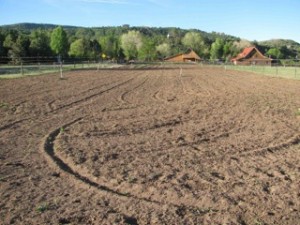 Our favorite harvest from the farm so far is hands down the kale and sweet onions. We started our onions in a tunnel on Valentines day so they are already bulbing and super sweet. We’ve included a recipe below for a raw kale salad that includes a way to use the onions as well. The kale is so packed with nutrition and tender this time of year, we will find it hard to ever eat lettuce again! Our favorite harvest from the farm so far is hands down the kale and sweet onions. We started our onions in a tunnel on Valentines day so they are already bulbing and super sweet. We’ve included a recipe below for a raw kale salad that includes a way to use the onions as well. The kale is so packed with nutrition and tender this time of year, we will find it hard to ever eat lettuce again!
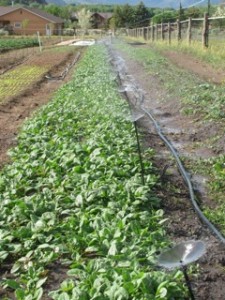 We are so excited to share our experiences farming with you throughout the summer. Please feel free to come by the farm and take a look, but make sure you call us first so we can show you around (the land and houses do not belong to us). Finally, thank you so much for your support which is helping to fulfill life-long dreams of your farmers. We are so excited to share our experiences farming with you throughout the summer. Please feel free to come by the farm and take a look, but make sure you call us first so we can show you around (the land and houses do not belong to us). Finally, thank you so much for your support which is helping to fulfill life-long dreams of your farmers.
Sincerely,
Linley, Peter, Werner
Mama Smith’s Raw Kale Salad
- 2 Tablespoons nutritional yeast
- 1 teaspoon sugar
- 4 teaspoons rice vinegar
- 4 teaspoons toasted sesame oil
- 1 clove minced garlic
- 12 oz kale, leaves cut into slender ribbons, massaged with 1 teaspoon olive oil
- 1/2 cup red onion
- 1/2 cup shredded carrots
- 3 Tablespoons toasted sesame seeds
- 1/4 cup toasted sliced almonds
- 1/4 cup rice noodles
Mix first five ingredients together for dressing. Toss salad and add dressing right before serving.
January 13th, 2013 Rosemary Limeade
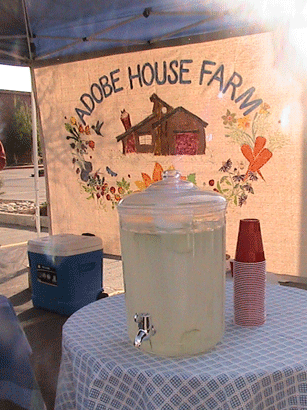 Rosemary Limeade for sale at the Durango Farmers’ Market Rosemary Limeade is a refreshing beverage that is perfect for a hot summer day. The rosemary adds a unique flavor that compliments the tart in the lime.
Ingredients:
- 2 cups sugar or honey (ours is made with local honey)
- 2 cups water
- 2 Sprigs Rosemary (4-6″)
- 2 cups freshly squeezed lime juice
- 12 cups water
- Simmer 2 cups of water, 2 cups of sugar or honey and rosemary sprigs in a medium saucepan for ten minutes, stirring occasionally.
- Remove from heat.
- Add 2 cups of freshly squeezed lime juice and 12 cups of water.
Serve chilled.
|
Contact AHF (970) 317-0309
linley@adobehousefarm.com
|
 This week’s harvest: zucchini, lettuce, cilantro, tomatoes, cucumber, dill, sweet red and white onions, kale, chard, eggplant (group A), strawberries (group B)
This week’s harvest: zucchini, lettuce, cilantro, tomatoes, cucumber, dill, sweet red and white onions, kale, chard, eggplant (group A), strawberries (group B)

















